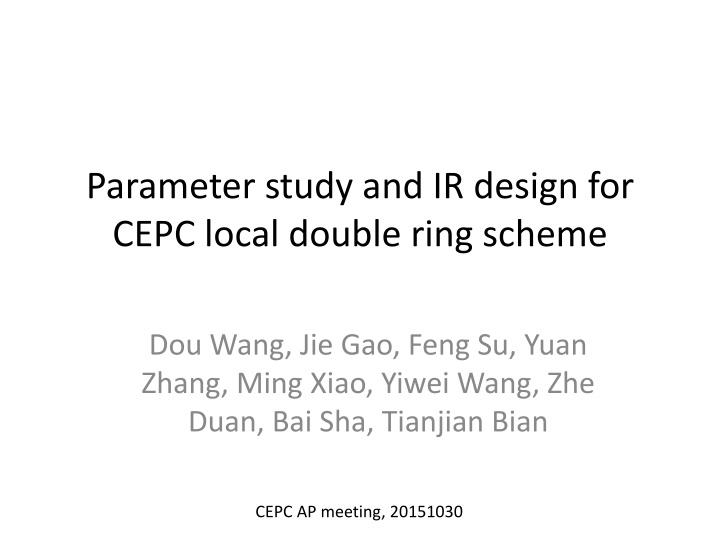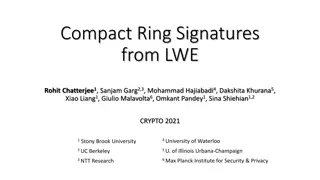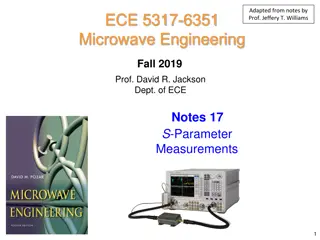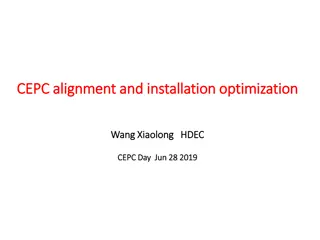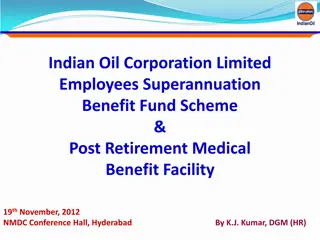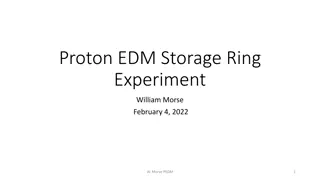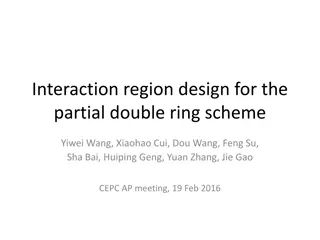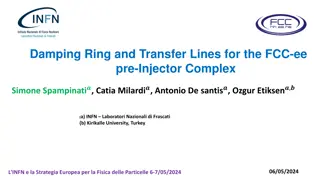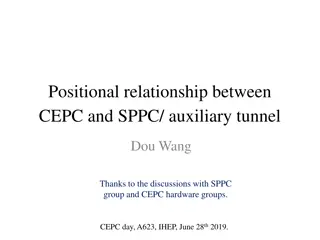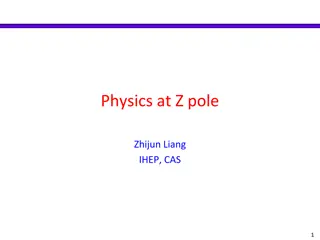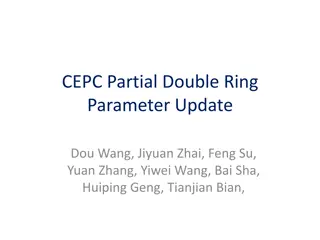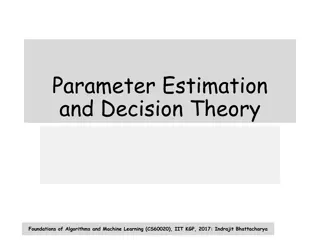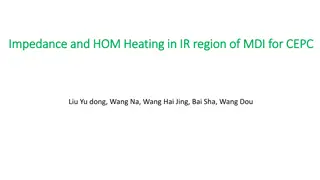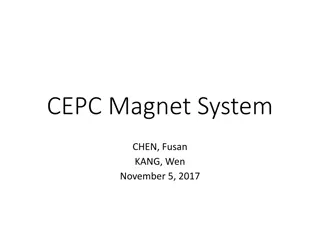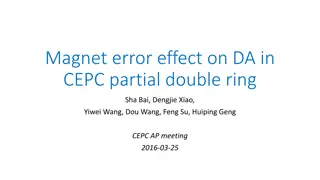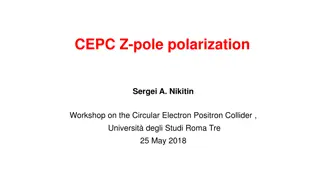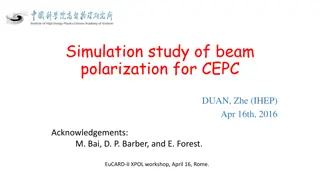CEPC Local Double Ring Scheme Parameter Study and IR Design
This study focuses on the parameter study and IR design for the CEPC local double ring scheme. It discusses machine constraints, given parameters, energy acceptance, emittance growth, beam lifetime limitations, effective bunch length, and more. The research aims to optimize the CEPC scheme for enhanced performance and efficiency during the AP meeting in 20151030.
Download Presentation

Please find below an Image/Link to download the presentation.
The content on the website is provided AS IS for your information and personal use only. It may not be sold, licensed, or shared on other websites without obtaining consent from the author.If you encounter any issues during the download, it is possible that the publisher has removed the file from their server.
You are allowed to download the files provided on this website for personal or commercial use, subject to the condition that they are used lawfully. All files are the property of their respective owners.
The content on the website is provided AS IS for your information and personal use only. It may not be sold, licensed, or shared on other websites without obtaining consent from the author.
E N D
Presentation Transcript
Parameter study and IR design for CEPC local double ring scheme Dou Wang, Jie Gao, Feng Su, Yuan Zhang, Ming Xiao, Yiwei Wang, Zhe Duan, Bai Sha, Tianjian Bian CEPC AP meeting, 20151030
Machine constraints / given parameters Energy E0 Circumference C0 NIP Beam power P0 y* R= y/ x Emittance coupling factor Bending radius Piwinski angle luminosity enhancement by crab waist Fl~1.5 Energy acceptance (DA) Phase advance per cell (FODO) A= 0/ BS(A>~3)
Parameter choice step 1 4 0 ( ) E GeV = 3 88.5 10 U 0 ( ) m eP U = 0 I b 0 C J = q 0 Beam-beam limit: 2845 2 U E N Fl: y enhancement by crab waist = * 0 F y l 2 0 IP *J. Gao, emittance growth and beam lifetime limitations due to beam-beam effects in e+e- storage rings, Nucl. Instr. and methods A533 2004 p. 270-274.
Parameter choice step 2 ( ( ) ) ( eE GeV N N T s ( ) = + 2 1 34 [ ] 2.17 10 1 0 b e L cm s r 0 y * y ) cm 0 2845 2 U E N = 0 F y l 2 0 IP E GeV I mA P MW N 1 ( ) = 0.7 10 + 0 0 b 2 1 34 1 L cm s r 0 cm y IP
Parameter choice step 3 N 0.1 e BS life time: 30 min 2 3 r + 2 0.2 1 2 e N x z e y = 2 r N 2 x 3 3 r = y: e y z e y y + 2 1 e y x y 2 e 3 r N = ( 3) 0 = A 0 3 2.6 BS rA A x y z e 2 y = = , r 5.77 y x y 0 y = y x 2 x + 2 1 rA y = = * x , y x x 3 4 1 60 + 2 3 2 4 1 sin sin C -- phase advance/cell, -- bending angle/cell. q 2 2 = x 3 8 sin cos J x 2 2 1 1 = 2 ( ) ( 2 ) Estimate : p 12 2 sin 2
Parameter choice step 4 + 2 2 1 I T eN = N 0 b y r = N b e x y e e y r N 2 3 0.1 = e e z 2 x 0.1 3 x = Arctg h r N 2 = tg z e e h x
Parameter choice step 5 Effective bunch length: overlap area of colliding bunches = x zeff sin h 2 y 2 y y = exp F K Hour glass effect: 0 h 2 zeff 2 zeff 2 2 zeff = L L F 0 h
Parameter choice step 6 = sin U eV 0 rf s Vrf, s 2 E A + 0 p = = R 0 0 z z 1 cos A f T eV 0 rf rf s Energy acceptance from RF: eV U 2 1 q U f T E rf = 1 arccos( ) = 2 0 q q RF 0 0 0 p rf
Parameter choice step 7 Beam lifetime due to radiative Bhabha scattering I ( ) bhabha = = 25 2 1.52 10 b cm ee eLN f 0 IP ee Beam lifetime due to Beamstrahlung 1.475 u 6 2 r e R = * e BS 2 0.057 c z *V.I. Telnov, "Issues with current designs for e+e- and gammagamma colliders , PoS Photon2013 (2013) 070. https://inspirehep.net/record/1298149/files/Photon%202013_070.pdf
Primary parameter design Pre-CDR crab waist-high lumi. crab waist-low power Number of IPs Energy (GeV) Circumference (km) SR loss/turn (GeV) Half crossing angle (mrad) Piwinski angle Ne/bunch (1011) Bunch number Beam current (mA) SR power /beam (MW) Bending radius (km) Momentum compaction (10-5) IPx/y (m) Emittance x/y (nm) Transverse IP(um) x/IP y/IP VRF(GV) fRF(MHz) Nature z(mm) Total z(mm) Energy spread (%) Energy acceptance (%) Energy acceptance by RF (%) n Life time due to beamstrahlung_cal (minute) F (hour glass) Lmax/IP (1034cm-2s-1) 2 2 2 120 54 3.1 0 0 3.79 50 16.6 51.7 6.1 3.4 120 54 2.96 13 2 3.75 50 16.9 50 6.2 3.1 120 54 2.96 11.5 2 2.81 40 10.1 30 6.2 2.6 0.8/0.0012 6.12/0.018 69.97/0.15 0.118 0.083 6.87 650 2.14 2.65 0.13 2 6 0.23 47 0.265/0.0012 3.55/0.01 30.7/0.11 0.04 0.11 3.6 650 3.5 4.7 0.13 2 2 0.5 77 0.22/0.001 2.67/0.008 24.3/0.09 0.04 0.11 3.6 650 2.6 4.2 0.13 2 2.2 0.47 41 0.68 2.04 0.71 2.91 0.69 2.03
Combine with local double ring lattice Choice 1 Choice 2
Double ring FFS design-case 1 Ec=110 keV Betax=0.8m Betay=0.003m
Double ring FFS design-case 2 Ec=110 keV Betax=0.8m Betay=0.003m
summary A consistent calculation method for CEPC parameter choice with carb waist scheme has been created. Based on crab waist scheme, we can get higher luminosity (2.91*1034cm-2s-1) keeping head-on beam power or to reduce the beam power (30 MW) keeping same luminosity. Two crab sextupoles should be designed soon. Local double ring lattice and IR design are ready. Two kinds of FFS has been design in order to compare the DA whole ring. First look of double ring DA including IR has been shown (Su Feng s report). More work need to be done to optimize the horizontal DA.
